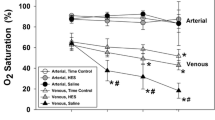Abstract
Objective: Mixed venous oxygen saturation (SvO2) is high despite a low hematocrit implies that the relationship between oxygen demand and supply is in a safe state. This study was sought to determine the critical values for hematocrit and SvO2 for safe cardiopulmonary bypass. Methods: Study 1: To evaluate the limit of hemodilution without cardiopulmonary bypass, normovolemic hemodilution with Dextran 40 (10%) was performed in 14 rabbits. SvO2 was monitored from the right atrium, and the hemodynamic parameters were recorded continuously. Study 2: To determine the critical values for hematocrit and SvO2 during cardiopulmonary bypass, normothermic and hypothermic cardiopulmonary bypass were performed in 13 rabbits and hemodynamic parameters were corrected. Results: Study 1: The heart rate decreased to unsafe levels abruptly, when the SvO2 was ≦43% or the hematocrit was ≦10%. The lactate concentration increased when the SvO2 was ≦46% or the hematocrit was ≦12%. Study 2: When the hematocrit was ≦12%, the SvO2 decreased gradually. Even when weaning was possible, the animals with a hematocrit ≦12% collapsed hemodynamically within 40 minutes after cardiopulmonary bypass. Most of the animals could not be weaned from cardiopulmonary bypass during either normothermic or hypothermic cardiopulmonary bypass when the SvO2 was ≦46%. Conclusions: Continuous monitoring of hematocrit and SvO2 provides evidence-based guidelines for safe cardiopulmonary bypass. The lower limits of critical range for a safer cardiopulmonary bypass are hematocrit of 12% and SvO2 of 46%.
Similar content being viewed by others
References
Cosgrove PM, Loop FD, Lytle BW. Blood conservation in cardiac surgery. Cardiovasc Clin 1982; 12: 165–75.
Cooley DA. Conservation of blood during cardiovascular surgery. Am J Surg 1995; 170: 53S-9S.
Osawa H, Tsuchiya K, Saito H, Furukawa H, Kabuto Y, Iida Y. Blood conservation in open-heart surgery: Avoiding predonated autologous blood. Jpn J Cardiovasc Surg 2000; 29: 63–7.
Kawashima Y, Yamamoto Z, Manabe H. Safe limits of hemodilution in cardiopulmonary bypass. Surgery 1974; 76: 391–7.
Takaori M, Safar P. Critical point in progressive hemodilution with hydroxyethyl starch. Kawasaki Med J 1976; 2: 211–22.
Kawamura M, Sakakibara K, Minamikawa O, Yoko-chi H, Kobayashi A. High-flow total body perfusion with severe hemodilution and normothermia in infants weighing less than 10 kg: Safe limits of hemodilution in cardiopulmonary bypass in infants. Jpn J Surg 1977; 7: 54–64.
Cook DJ, Orszulak TA, Daly RC. Minimum hematocrit at differing cardiopulmonary bypass temperatures in dogs. Circulation 1998; 98: II-170–5.
Schmidt CR, Frank LP, Forsythe SB, Estafanous FG. Continuous SvO2 measurement and oxygen transport patterns in cardiac surgery patients. Crit Care Med 1984; 12: 523–7.
Nelson LD. Continuous venous oximetry in surgical patients. Ann Surg 1986; 203: 329–33.
Page PA, Birenbaum IB, Thomas L, Baldwin RC, Benak A. Optimizing cardiopulmonary bypass utilizing continuous oxygen saturation monitoring. J Extra Corporeal Technol 1984; 16: 62–7.
Goodnough LT, Despotis GJ, Hogue CW Jr, Ferguson TB Jr. On the need for improved transfusion indicators in cardiac surgery. Ann Thorac Surg 1995; 60: 473–80.
Brown ME, Rawleigh JD, Gallagher JM. In vitro evaluation of continuous mixed venous oxygen saturation and hematocrit monitors. J Extra Corporeal Technol 1994; 26: 189–93.
Higuchi H, Yoshii S, Osawa H, Suzuki S, Samuel A, Hosaka S, et al. Whole-body oxygen consumption at different temperatures during cardiopulmonary bypass (Eng abstr). Kyobu Geka 2000; 53: 841–6.
Baraka A, Baroody M, Haroun S, Nawfal M, Dabbous A, Sibai A, et al. Continuous venous oximetry during cardiopulmonary bypass: Influence of temperature changes, perfusion flow, and hematocrit levels. J Cardiothorac Anesth 1990; 4: 35–8.
Fox LS, Blackstone EH, Kirklin JW, Stewart RW, Samuelson PN. Relationship of whole body oxygen consumption to perfusion flow rate during hypothermic cardiopulmonary bypass. J Thorac Cardiovasc Surg 1982; 83: 239–48.
Irita K, Kai Y, Takahashi S. Impaired oxygen utilization during rapid cooling on cardiopulmonary bypass. Fukuoka Acta Med 1999; 90: 14–22.
Hickey RF, Hoar PF. Whole-body oxygen consumption during low-flow hypothermic cardiopulmonary bypass. J Thorac Cardiovasc Surg 1983; 86: 903–6.
Clark LC Jr. Optimal flow rate in perfusion. In: Allen JG ed. Extracorporeal circulation. Springfield, IL; Thomas, 1958, 156.8–157.12.
Shin’oka T, Shum-Tim D, Jonas RA, Lidov HG, Laussen PC, Miura T, et al. Higher hematocrit improves cerebral outcome after deep hypothermic circulatory arrest. J Thorac Cardiovasc Surg 1996; 112: 1610–21.
McDaniel LB, Zwischenberger JB, Vertrees RA, Nutt L, Uchida T, Nguyen T, et al. Mixed venous saturation during cardiopulmonary bypass poorly predicts regional venous oxygen saturation. Anesth Analg 1995; 80: 466–72.
Croughwell ND, White WD, Smith LR, Davis RD, Glower DD Jr, Reves JG, et al. Jugular bulb saturation and mixed venous saturation during cardiopulmonary bypass. J Card Surg 1995; 10 (4 Suppl): 503–8.
Cook DJ, Oliver WC Jr, Orszulak TA, Daly RC, Bryce RD. Cardiopulmonary bypass temperature, hematocrit, and cerebral oxygen delivery in humans. Ann Thorac Surg 1995; 60: 1671–7.
Cook DJ, Orszulak TA, Daly RC, MacVeigh I. Minimum hematocrit for normothermic cardiopulmonary bypass in dogs. Circulation 1997; 96 (9 Suppl): II-200–4.
Sungurtekin H, Cook DJ, Orszulak TA, Dary RC, Mullany CJ. Cerebral response to hemodilution during hypothermic cardiopulmonary bypass in adults. Anesth Analg 1999; 89: 1078–83
Author information
Authors and Affiliations
Rights and permissions
About this article
Cite this article
Osawa, H., Yoshii, S., Abraham, S.J. et al. Critical values of hematocrit and mixed venous oxygen saturation as parameters for a safe cardiopulmonary bypass. Jpn J Thorac Caridovasc Surg 52, 49–56 (2004). https://doi.org/10.1007/s11748-004-0083-2
Received:
Accepted:
Issue Date:
DOI: https://doi.org/10.1007/s11748-004-0083-2




